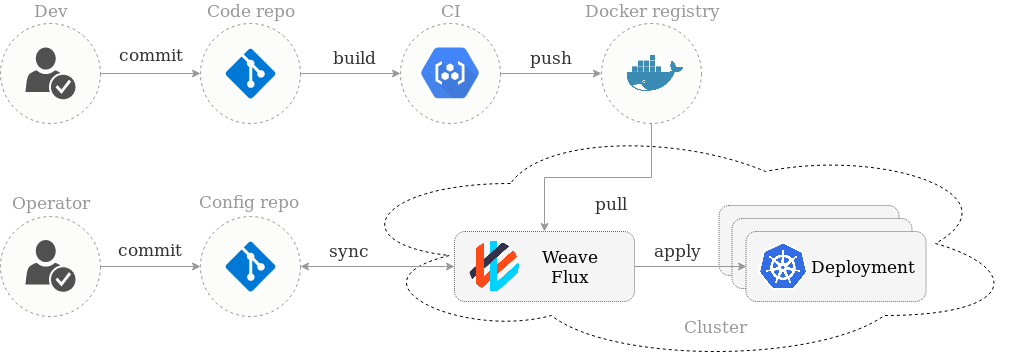We believe in GitOps:
- You declaratively describe the entire desired state of your system in git. This includes the apps, config, dashboards, monitoring and everything else.
- What can be described can be automated. Use YAMLs to enforce
conformance of the system. You don't need to run
kubectl, all changes go through git. Use diff tools to detect divergence between observed and desired state and get notifications. - You push code not containers. Everything is controlled through pull requests. There is no learning curve for new devs, they just use your standard git PR process. The history in git allows you to recover from any snapshot as you have an sequence of transactions. It is much more transparent to make operational changes by pull request, e.g. fix a production issue via a pull request instead of making changes to the running system.
Flux is a tool that automatically ensures that the state of a cluster matches the config in git. It uses an operator in the cluster to trigger deployments inside Kubernetes, which means you don't need a separate CD tool. It monitors all relevant image repositories, detects new images, triggers deployments and updates the desired running configuration based on that (and a configurable policy).
The benefits are: you don't need to grant your CI access to the cluster, every change is atomic and transactional, git has your audit log. Each transaction either fails or succeeds cleanly. You're entirely code centric and don't need new infrastructure.
Flux is most useful when used as a deployment tool at the end of a Continuous Delivery pipeline. Flux will make sure that your new container images and config changes are propagated to the cluster.
Its major features are:
- Automated git → cluster synchronisation
- Automated deployment of new container images
- Integrations with other devops tools (Helm and more)
- No additional service or infrastructure needed - Flux lives inside your cluster
- Straight-forward control over the state of deployments in the cluster (rollbacks, lock a specific version of a workload, manual deployments)
- Observability: git commits are an audit trail, and you can record e.g., why a given deployment was locked.
Weave Cloud is a SaaS product by Weaveworks that includes Flux, as well as:
- a UI and alerts for deployments: nicely integrated overview, all flux operations just a click away.
- full observability and insights into your cluster: Instantly start using monitoring dashboards for your cluster, hosted 13 months of history, use a realtime map of your cluster to debug and analyse its state.
If you want to learn more about Weave Cloud, you can see it in action on its homepage.
Get started by browsing through the documentation below:
- Background about Flux
- Get Started with Flux
- Operating Flux
Flux follows a typical PR workflow. All contributions should be made as PRs that satisfy the guidelines below.
- All code must abide Go Code Review Comments
- Names should abide What's in a name
- Code must build on both Linux and Darwin, via plain
go build - Code should have appropriate test coverage, invoked via plain
go test
In addition, several mechanical checks are enforced. See the lint script for details.
If you have any questions about Flux and continuous delivery:
- Read the Weave Flux docs.
- Invite yourself to the Weave community slack.
- Ask a question on the #flux slack channel.
- Join the Weave User Group and get invited to online talks, hands-on training and meetups in your area.
- Send an email to [email protected]
- File an issue.
Your feedback is always welcome!
